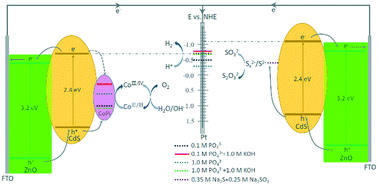Structural modulation of CdS/ZnO nanoheterojunction arrays for full solar water splitting and their related degradation mechanisms†
Abstract
The loading of a cocatalyst is an important strategy for developing efficient and stable photoanodes. CdS/ZnO nanoheterojunction arrays (NHAs) are not suitable for full solar water splitting due to the easy photocorrosion of CdS if there is no sacrificial agent. Herein, CoPi was loaded onto CdS/ZnO NHAs to improve the PEC current and stability. Heat treatment had a critical effect on the PEC performance of the Co-Pi-loaded NHA. The higher crystallinity of the CdS layer with CdCl2-assisted treatment affords the largest stable current (2.5 mA cm−2) for 3 h without performance degradation in 0.1 M phosphate solution (pH = 14). According to the measured band/electrolyte level alignment, the smaller current for full water splitting compared to that in the sacrificial solution is attributed to the large hole transfer resistance owing to the lowered conduction band with CoPi loading. The decrease in photocurrent over 3 h was demonstrated to be due to the photocorrosion of CdS and then the chemical corrosion of ZnO by the phosphate solution. The results suggest that the PEC performance is expected to be improved by optimizing the cocatalyst and the electrolyte solution.



 Please wait while we load your content...
Please wait while we load your content...